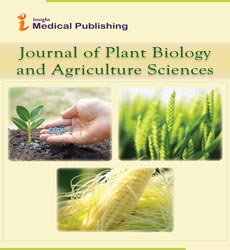Morphometric trait variability of autochthonous Walnut (Juglans regia l.) in the north-western Himalayan region
Abstract
The assessment of variability is the first step of crop improvement and selection of superior clones which depends on the extent of genetic variability present within the gene pool. Therefore the present study was undertaken to study the genetic variability of autochthonous walnut and to analyze the degree of association between different nut traits through correlation and path analysis. The correlation matrix was subjected to PCA to quantify and find out major contributing traits and genotypes towards genetic diversity. Nut weight being an important trait showed positive correlation with nut width (r = 0.540), nut thickness (r = 0.518), kernel weight (r = 0.765) and kernel percent which is other important trait also showed positive correlation with kernel weight (r = 0.582) and negative correlation with shell per cent (r = -0.969) and shell thickness (r = -0.890).Kernel weight had a maximum (0.947, 0.898) direct effect at phenotypic and genotypic respectively, on nut weight and maximum positive indirect effects on nut weight were exhibited by kernel percent (0.696) via kernel weight. Kernel weight, kernel percent, Shell percent, and Shell thickness were the most contributing traits in the PC1, whereas nut weight was the principal trait of PC2. Among genotypes, JWSG-43 and JWSM-29 were most contributing (%) to PC1 and PC2. Based on the quality of representation on the factor map kernel percent> shell percent> kernel weight> shell thickness and nut weight was the major important contributing traits and among genotypes, JWSD-18 and JWSG-43 were the most prominent contributing genotypes. This research helps to identify the relative amount of variability in nut traits and genotypes and detect and reveal the most important traits and genotypes that explain the variability in the dataset. Furthermore, robust identification of important traits in this study can help to reduce the costs and time associated with phenotyping of all nut and kernel traits of each genotype and will help the breeder in the precise selection of promising genotypes based on the objective of the walnut breeding program.
Open Access Journals
- Aquaculture & Veterinary Science
- Chemistry & Chemical Sciences
- Clinical Sciences
- Engineering
- General Science
- Genetics & Molecular Biology
- Health Care & Nursing
- Immunology & Microbiology
- Materials Science
- Mathematics & Physics
- Medical Sciences
- Neurology & Psychiatry
- Oncology & Cancer Science
- Pharmaceutical Sciences
